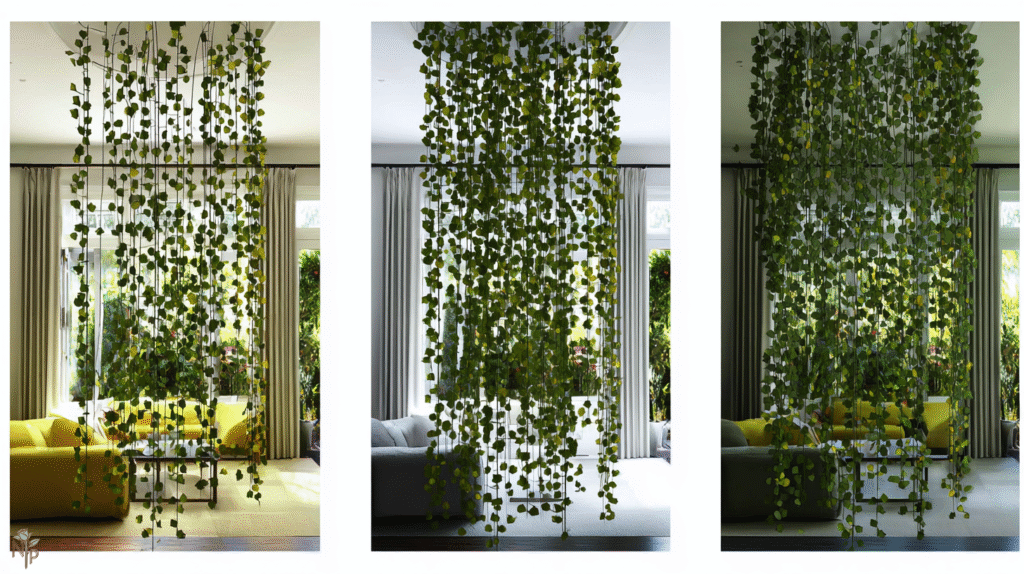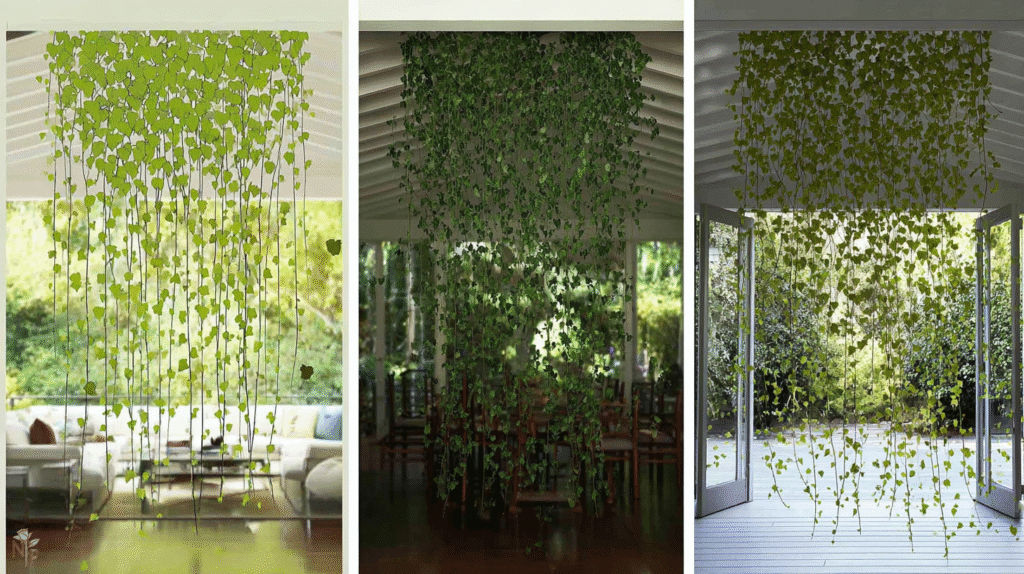My first ivy looked like a balding man’s combover – three lonely vines desperately trying to cover an entire pot. I’d see those Instagram photos of cascading ivy waterfalls and wonder what kind of sorcery people were using. Mine just… existed. Not dying, but definitely not thriving.
Fast forward two years and multiple ivy casualties later, and I’ve got ivy coming out of my ears. Literally had to give cuttings away because they were taking over my apartment. My bathroom ivy is so thick you can’t see the wall behind it. The one in my living room? People think it’s fake because it’s “too perfect.”
Turns out, getting that thick, lush ivy isn’t about having a green thumb. It’s about knowing the weird little tricks nobody mentions. Like how ivy secretly wants to be hair – the more you cut it, the thicker it grows. Or how one strategic pinch in the right spot can turn a stringy vine into a bushy masterpiece.
The Biggest Lie About Indoor Ivy
Everyone says ivy is easy. “Grows anywhere!” they said. “Perfect for beginners!” they promised. Then you bring one home and it immediately starts dropping leaves like it’s autumn.
Here’s what they don’t tell you: ivy is easy… once you crack its code. But that code is weirdly specific. It’s like having a cat that only drinks water from the bathroom faucet at exactly 3 PM. Ridiculous? Yes. But once you know, it’s simple.
My breakthrough came when I stopped treating ivy like a houseplant and started treating it like what it actually is – a vine that’s supposed to be climbing up European buildings, not sitting in a pot pretending to be a fern.

Light: The More the Better (With One Huge Exception)
Every care guide says ivy tolerates low light. Sure, it tolerates it the way I tolerate my neighbor’s music – barely, and with visible distress.
My sad, stringy bathroom ivy transformed when I moved it to a bright window. Went from growing maybe one leaf a month to pushing out new growth weekly. But here’s the catch – direct afternoon sun will fry it faster than bacon.
What actually works: Morning sun is gold. East window? Perfect. I’ve got one ivy that gets blasted with sunrise for three hours, then bright indirect light all day. Thing grows so fast I have to trim it monthly.
North window ivy? Still alive after a year but grows like it’s in slow motion. Added a cheap grow light (like $15 on Amazon) and boom – suddenly it remembered how to grow.
The variegated types (the ones with white or yellow in the leaves) are even pickier. Less light = they turn solid green. Lost all the pretty patterns on my ‘Glacier’ ivy until I moved it to brighter light. Took two months but the variegation came back.
The Pinching Secret That Changed Everything
This one trick turned my stringy ivy into a bushy monster. Ready? Pinch the tips. That’s it. But do it right.
See, ivy wants to grow long, not full. One vine will happily grow 20 feet without branching if you let it. But pinch off the growing tip? It panics and shoots out 2-3 new vines from below. Pinch those tips? More branches. It’s like a exponential growth hack.
My pinching routine: Every time a vine grows 6 inches, I pinch off the top 2 inches. Yes, it hurts to cut new growth. Do it anyway. Within two weeks, you’ll see little nubs forming where leaves meet the stem. Those turn into new vines.
Started with 3 vines on my pothos ivy. After six months of strategic pinching, I stopped counting at 15. The thing looks like a green waterfall now.
Pro tip: Don’t throw away those pinched pieces. Stick them in water, grow roots, plant them back in the same pot. Instant fullness multiplier.
Water: The Goldilocks Zone Is Real
Killed my first ivy by watering it like my pothos – whenever I remembered, usually weekly. Turns out ivy is pickier than my coffee order.
Too dry? Leaves get crispy and fall off. Too wet? Leaves turn yellow and fall off. The symptoms are annoyingly similar, which is super helpful when you’re trying to figure out what’s wrong.
The finger test that actually works: Forget the “top inch dry” rule. For ivy, I go two knuckles deep. If it’s dry down there, water. If there’s any moisture, wait a day. In summer, that’s usually twice a week. Winter? Maybe every 10 days.
But here’s the game-changer: the weight test. Lift your pot when it’s freshly watered. Heavy, right? Lift it again in a few days. Getting lighter? Almost time. Feels like an empty pot? Water immediately.
My bathroom ivy gets more water than my bedroom one because bathroom = more heat and airflow from showers. Same plant, different needs based on location.
Humidity: The Missing Piece
Wondered why your ivy gets crispy edges even when you’re watering perfectly? It’s the humidity, stupid. (That’s what I told myself after killing ivy number three.)
Indoor air, especially in winter, is drier than stale crackers. Ivy wants 40-50% humidity minimum. Most homes? Lucky to hit 30%.
Fixes that actually work: Pebble trays are fine but honestly barely make a difference. Grouping plants together? Better. But the real winner? Bathroom placement if you have a window. My shower ivy grows like it’s on steroids from the steam.
For everywhere else, I mist. But not the plant – the air around it. Direct misting caused spots on my leaves. Now I spray above and let it fall like rain. Twice a day in winter when the heat’s blasting.
Cheap humidity meter from the hardware store ($5) was a game-changer. Realized my living room was at 25% humidity in winter. No wonder everything was crispy.

Fertilizer: Less Drama Than You’d Think
Went through a phase where I thought fertilizer was the secret to lush growth. Bought fancy organic this, specialized that. My ivy didn’t care.
Now? Generic balanced liquid fertilizer, half strength, once a month in growing season. That’s March through September for me. Winter? Nothing. They’re basically hibernating.
Over-fertilized once (because more is better, right?). Leaves got these weird brown spots and new growth came out deformed. Had to flush the soil with water and stop feeding for two months to fix it.
The Propagation Hack for Instant Fullness
Want thick ivy fast? Don’t wait for one plant to fill out. Make more plants.
Every time I trim, those cuttings go in water. Once they have 2-inch roots (about 3 weeks), I plant them right back in the original pot. Started with one plant in a 6-inch pot. Now there’s technically seven plants in there. Looks like one magnificent bushy beast.
Spring cuttings root fastest. Summer works too. Fall is slow. Winter? Forget it, they just rot.
Water propagation setup: Clear glass (so you can see root progress), change water weekly, and here’s the weird part – add a pothos cutting to the same glass. I swear ivy roots faster with a pothos buddy. No idea why. Discovered it by accident when I was too lazy to get another glass.
Common Problems That Almost Made Me Give Up
Spider mites:
These invisible jerks almost killed my entire collection. Tiny webs between leaves? That’s them. Shower the whole plant weekly. Literally put it in the shower, lukewarm water, decent pressure. Prevents and treats mild infestations.
Leaves dropping:
Usually water related. But sometimes it’s the plant adjusting to your house. My new ivy always drops leaves for two weeks then settles down. Now I expect it and don’t panic.
Leggy growth in winter:
Normal. Don’t freak out. Just trim come spring and it’ll bush up again. I used to stress about winter growth. Now I just let it do its ugly phase.
Brown tips:
Either humidity, fluoride in tap water, or fertilizer burn. I switched to filtered water and the problem disappeared.

The Setup That Finally Worked
After all the experiments, here’s what my thriving ivy gets:
- Bright indirect light (east window or grow light assisted)
- Water when two knuckles deep is dry
- Misting the air daily in winter
- Monthly feeding spring through fall
- Ruthless pinching and propagating
- Shower spa treatment monthly for pest prevention
The one in my bathroom barely needs attention because the conditions are naturally perfect. The living room one needs more hovering but rewards me with growth so dense you can’t see through it.
Real Talk
Getting thick, lush ivy indoors isn’t instant. My “overnight success” took eight months of pinching, propagating, and replanting. But once it hits critical mass? Unstoppable.
The secret isn’t one thing – it’s all the little things. More light than you think. More pinching than feels comfortable. More cuttings shoved back in the pot. Less water than seems right. It’s basically controlled chaos that somehow works.
My stringy, pathetic first ivy is now so full I have to tie it up to keep it from taking over the bookshelf. And every time someone asks if it’s real, I get stupidly proud. Because two years ago, I couldn’t keep one alive, and now I’m the ivy whisperer of my friend group.






